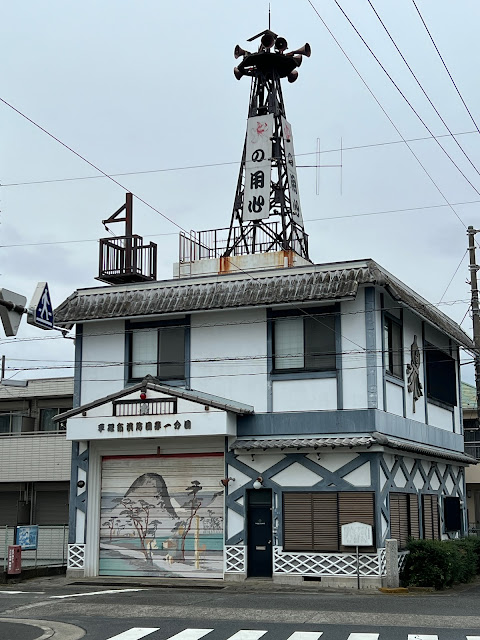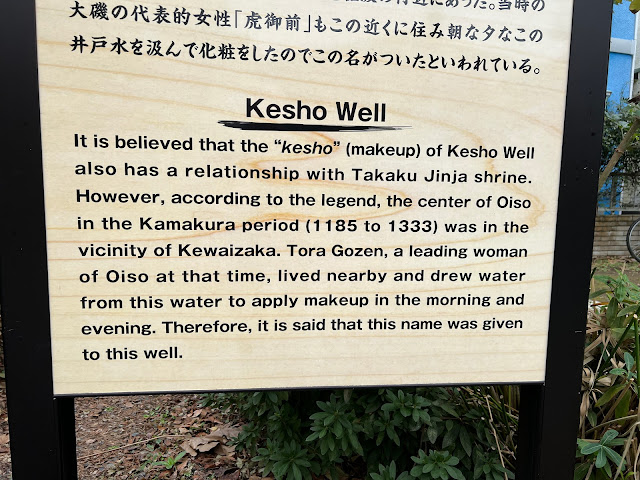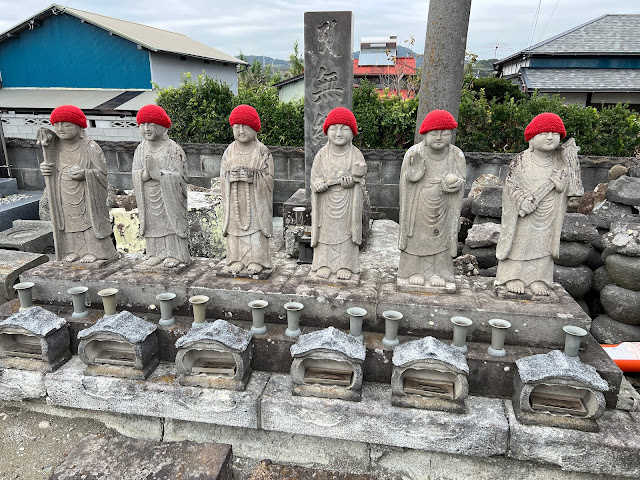The first half of today’s walk was the most pleasant and interesting yet. Although it followed busy Route 1 most of the way, traffic was a little lighter, perhaps by virtue of being Sunday. The weather was a copy of the previous day’s, although perhaps a degree or two cooler. Certainly the low clouds ruled out any possibility of seeing Mt Fuji.
On the outskirts of Hiratsuka, roller doors beneath what appears to be an emergency warning tower depict one of the most famous of Hiroshige’s 53 Station of the Todkaido.Other walkers whose accounts I’d read had attempted to capture the same scene, and I felt obliged to make my own contribution to the genre:
As others point out, Hiroshige clearly took liberties with the shape of the hill. On the side of the road opposite, where the Old Tokaido rejoins Route 1 just before crossing a river, a mini ichirizuka has been created.
Over the river and into the town of Oiso, the manhole covers change to reflect the area’s coastline. With a long beach and easy accessibility from Tokyo, this is a popular summer destination. No one was like to be frolicking in that waves today, however.
It was at this point that one of the promises I’d made to myself went out the window. Passing a McDonald’s and being in need of a quick stop, I justified my decision with the rationale that a) there would be a toilet inside and b) I hadn’t had much breakfast and was entitled to a top-up. Falling back on the ‘point at a picture and say please’ method of ordering, I ended up with a burger that was distinctly Japanese, having what tasted like a soy-based sauce rather than ketchup. Not too bad, but I won’t make a habit of it. The other reliable source of facilities for needy travellers are the ubiquitous konbini (convenience stores), which all seems to have restrooms whose use can be justified by the purchase of a snack for a couple of hundred yen.
Near Maccas, the new Route 1 veered left away from the Old Tokaido. Note the line of pine trees along the old road on the right of the shot.
Actually the Old Tokaido was much more pleasant along this stretch than this shot suggests. Once past the ugly and apparently defunct gallery in the centre of the shot, it turned into a quiet, tree-lined road with houses on both sides set back from the road and plenty of references to its history.
What I think this boils down to is that a woman used to sit at the well to do her make-up, and so the became known as the Kesho (make-up) Well.
Other signboards point out the locations of ichirizuka and show the Hiroshige print relating to the area.
All too soon back on Route 1, a hobby shop window had Godzilla looming over exquisitely detailed model railways displays.
And a little further on from that, a tiny church was squeezed between two apartment buildings. Someone was vacuuming inside – presumably tidying up after a service, this being Sunday – or I would have gone in.
And just beyond that I came across Shigitatsuan, which is described as a hermitage, but perhaps would be described in the West as a cultural centre for the study and appreciation of haiku above all, but other forms of traditional poetry and tea ceremonies as well.
A modest entrance fee grants admission to a small but deliciously peaceful garden filled with small buildings and shrine, statues, and gravestones of previous owners engraved with haiku. Here’s a haiku translated in the brochure I picked up at the entrance: “Spring mist covers the cherry blossom like our heart.” Another, more seasonally appropriate: “A single leaf fell in an autumn evening.”
A sign in front of a stone pillar describes it as Basho Haiku Monument. As I’m reading Basho’s Narrow Road to the Deep North, very generously given to me by Barbara before leaving Sydney, I particularly enjoyed finding this one.
On a rotunda near the top, two young women in what I assume were anime-inspired costumes were posing for photographs taken by a very professional-looking cameraman.
Following the fork of the Old Tokaido led past a cemetery, where statues of Buddha (I assume) had been decorated with very jolly little beanies. If anyone knows the significance of this, please let me know in the comments.
Soon enough, though, I rejoined Route 1, passing another interesting little shrine.
By 5 o’clock it was pretty dark and I still had quite a long way to go. I was starting to get hungry, so rather than wait until reaching Odawara I decided to check out any restaurants I came across. For some reason I had a craving for carbonara, and lo and behold not a kilometre or two further on I spotted Macaroni Market, a barn-like place that sold pasta-related goods at the front and had a restaurant at the back. Scanning the menu, I recognised the katakana for carbonara (karubonara) and ordered from the very friendly waitress, who told me she was learning English. I apologiesed for my lack of Japanese and showed her my intro. She asked if I was part of a walking club, and seemed astonished when I explained I was doing the walk on my own. I asked her name and she said I should call her Misha. As I paid the bill and left she said it had been very nice to meet me and told me to take care. The carbonara wouldn’t win any prized (I mean, who goes to Japan to eat Italian food?), but I felt like a had met my new goal of having at least one brief conversation a day with someone I meet and explaining what I’m up to. No photo of Misha, as she was working and I didn’t want to put her into an awkward position if that had been inappropriate.
On the outskirts of Odawarra, I also fulfilled the day’s other obligation, passing a particularly beautiful shrine and pausing to pay my respects – being very careful to wash beforehand.
The photo doesn’t really do it justice.
And so into the back streets of Odawara and back to the Terminal Hotel. By now my legs had found all sorts of new and interesting ways of hurting, and I very much regretted the climb to the top of Oisojoyama Park earlier in the day. It was nearly 7 o’clock by the time I got back to my room, and I was exhausted. I was in bed soon after 8.





















Comments
Post a Comment